Enterprise re-retired
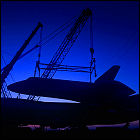 Having already been donated to the Smithsonian Air & Space Museum in 1985, Space Shuttle Enterprise, a test vehicle not built to spaceflight specs, is removed from the custom-made hangar at the Smithsonian and prepared for re-gifting. With NASA donating the space-flown shuttle Discovery to the Smithsonian, Enterprise will now become a major display at New York City’s Intrepid Museum, based on the retired aircraft carrier U.S.S. Intrepid. For the first time in nearly 20 years, Enterprise is loaded onto one of the modified Boeing 747s from which it made its in-atmosphere test flights in 1977 and is transported to New York.
Having already been donated to the Smithsonian Air & Space Museum in 1985, Space Shuttle Enterprise, a test vehicle not built to spaceflight specs, is removed from the custom-made hangar at the Smithsonian and prepared for re-gifting. With NASA donating the space-flown shuttle Discovery to the Smithsonian, Enterprise will now become a major display at New York City’s Intrepid Museum, based on the retired aircraft carrier U.S.S. Intrepid. For the first time in nearly 20 years, Enterprise is loaded onto one of the modified Boeing 747s from which it made its in-atmosphere test flights in 1977 and is transported to New York.
Retirement homes for Space Shuttles
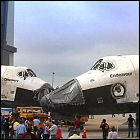 NASA announces the results of a bidding process for soon-to-be-retired Space Shuttle vehicles by institutions across the country. The original test vehicle, Enterprise, will be removed from the Smithsonian and replaced by the space-flown Discovery, while Atlantis will become the centerpiece of a new exhibit at NASA’s own Kennedy Space Center. Endeavour will be handed over to the California Science Museum in Los Angeles, while Enterprise’s new home will be in New York City’s Intrepid Museum. Institutions not selected to receive one of the shuttles, including NASA’s Johnson Space Center in Houston, Texas, almost immediately claim that the selection process has been swayed by politics. None of the vehicles will be transported from Kennedy Space Center to their new locations until the following year.
NASA announces the results of a bidding process for soon-to-be-retired Space Shuttle vehicles by institutions across the country. The original test vehicle, Enterprise, will be removed from the Smithsonian and replaced by the space-flown Discovery, while Atlantis will become the centerpiece of a new exhibit at NASA’s own Kennedy Space Center. Endeavour will be handed over to the California Science Museum in Los Angeles, while Enterprise’s new home will be in New York City’s Intrepid Museum. Institutions not selected to receive one of the shuttles, including NASA’s Johnson Space Center in Houston, Texas, almost immediately claim that the selection process has been swayed by politics. None of the vehicles will be transported from Kennedy Space Center to their new locations until the following year.
Enterprise retired
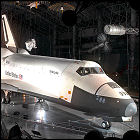 The Space Shuttle Enterprise arrives to begin its new life as a star exhibit at the Smithsonian Air & Space Museum in Washington D.C. Having used the Enterprise as a test shuttle for landings and engineering fit checks, and having dispatched it on a world tour of air shows and other public appearances, NASA donates Enterprise to the Smithsonian, as any plans to refit it into a spaceworthy orbiter have been nixed by this point.
The Space Shuttle Enterprise arrives to begin its new life as a star exhibit at the Smithsonian Air & Space Museum in Washington D.C. Having used the Enterprise as a test shuttle for landings and engineering fit checks, and having dispatched it on a world tour of air shows and other public appearances, NASA donates Enterprise to the Smithsonian, as any plans to refit it into a spaceworthy orbiter have been nixed by this point.
“The test flights are over”
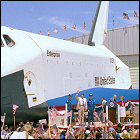 Space Shuttle Columbia lands at Edwards Air Force Base in California, making its first-ever landing on a concrete runway. After greeting the returning astronauts and inspecting the shuttle, President Ronald Reagan – with the partially-dismantled prototype Enterprise as a backdrop – declares NASA’s Space Shuttle system fully operational, saying “the test flights are over.” Columbia Commander Ken Mattingly later reveals that there was tremendous pressure on NASA to land Columbia on Independence Day, regardless of how many mission objectives had been met, to maximize the publicity value of the President’s speech. But the quick turnaround time and almost-weekly flight schedule that NASA had publicized throughout the 1970s is already a pipe dream: post-mission the four missions flown so far prove that post-landing servicing of each orbiter takes longer than expected. Columbia won’t fly again until the first “operational” mission in November.
Space Shuttle Columbia lands at Edwards Air Force Base in California, making its first-ever landing on a concrete runway. After greeting the returning astronauts and inspecting the shuttle, President Ronald Reagan – with the partially-dismantled prototype Enterprise as a backdrop – declares NASA’s Space Shuttle system fully operational, saying “the test flights are over.” Columbia Commander Ken Mattingly later reveals that there was tremendous pressure on NASA to land Columbia on Independence Day, regardless of how many mission objectives had been met, to maximize the publicity value of the President’s speech. But the quick turnaround time and almost-weekly flight schedule that NASA had publicized throughout the 1970s is already a pipe dream: post-mission the four missions flown so far prove that post-landing servicing of each orbiter takes longer than expected. Columbia won’t fly again until the first “operational” mission in November.
Enterprise rolls out to the pad
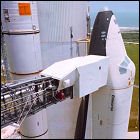 The Space Shuttle Enterprise, a full-sized, full-weight test article not intended for orbital flight, is mated to an external tank and a pair of solid rocket boosters and rolled out to Launch Complex 39A at Cape Canaveral for engineering fit-checks of the redesigned launch pad (a hand-me-down from the Apollo era, where the same pad had launched all but one of the Saturn V rockets). Enterprise remains on the pad for over a month, providing the first photo opportunity of the full-size shuttle launch stack in all of its glory.
The Space Shuttle Enterprise, a full-sized, full-weight test article not intended for orbital flight, is mated to an external tank and a pair of solid rocket boosters and rolled out to Launch Complex 39A at Cape Canaveral for engineering fit-checks of the redesigned launch pad (a hand-me-down from the Apollo era, where the same pad had launched all but one of the Saturn V rockets). Enterprise remains on the pad for over a month, providing the first photo opportunity of the full-size shuttle launch stack in all of its glory.
Enterprise Approach & Landing Test 5
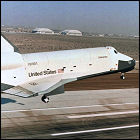 Astronauts Fred Haise and Gordon Fullerton bring Space Shuttle Enterprise back to the ground safely for its fifth free-flight landing test, the second to land with the shuttle’s engines exposed and the first to land on an actual paved runway at Edwards Air Force Base. The crew successfully compensates for a “bouncing” problem experienced on previous shuttle test landings, proving that Enterprise’s sister ships should be able to land safely after returning from orbit. Following this test, Enterprise is slated to undergo a major refit to finish it out into a spaceworthy orbiter, but NASA ultimately decides the process is too expensive. This is the final free-flight of Space Shuttle Enterprise.
Astronauts Fred Haise and Gordon Fullerton bring Space Shuttle Enterprise back to the ground safely for its fifth free-flight landing test, the second to land with the shuttle’s engines exposed and the first to land on an actual paved runway at Edwards Air Force Base. The crew successfully compensates for a “bouncing” problem experienced on previous shuttle test landings, proving that Enterprise’s sister ships should be able to land safely after returning from orbit. Following this test, Enterprise is slated to undergo a major refit to finish it out into a spaceworthy orbiter, but NASA ultimately decides the process is too expensive. This is the final free-flight of Space Shuttle Enterprise.
The Space Shuttle’s ambitious schedule
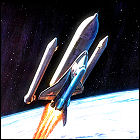 NASA prepares a preliminary schedule of Space Shuttle launches, covering the years 1979-1982 (and assuming the shuttle will be ready to launch in 1979). The ambitious schedule (which also assumes, in line with current planning, that the test orbiter Enterprise will be upgraded to spaceworthiness) includes almost-monthly flights from 1979 onward to deploy communications and weather satellites already on the drawing board, as well as frequent science missions with the cargo-bay-mounted Spacelab. On only the second test flight, the schedule has OV-102 (yet to be named Columbia) slated for a mission to the abandoned early 1970s space station Skylab, using a teleoperator retrieval system which also exists only on paper. While many of the schedule’s goals will be met, the delay in the shuttle program will be longer than NASA anticipates at this time.
NASA prepares a preliminary schedule of Space Shuttle launches, covering the years 1979-1982 (and assuming the shuttle will be ready to launch in 1979). The ambitious schedule (which also assumes, in line with current planning, that the test orbiter Enterprise will be upgraded to spaceworthiness) includes almost-monthly flights from 1979 onward to deploy communications and weather satellites already on the drawing board, as well as frequent science missions with the cargo-bay-mounted Spacelab. On only the second test flight, the schedule has OV-102 (yet to be named Columbia) slated for a mission to the abandoned early 1970s space station Skylab, using a teleoperator retrieval system which also exists only on paper. While many of the schedule’s goals will be met, the delay in the shuttle program will be longer than NASA anticipates at this time.
Enterprise Approach & Landing Test 4
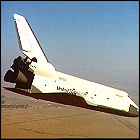 Space Shuttle Enterprise makes its fourth free-flight after separating from its modified Boeing 747 carrier aircraft, gliding to a safe landing at Edwards Air Force Base’s dry lake bed runway. For the first time, Enterprise’s engines are left exposed, adding to the drag experienced by the gliding shuttle rather than masking the engines with a protective cover. This more accurately simulates the aerodynamics of a shuttle returning from space. Enterprise’s crew for the two-and-a-half-minute flight consists of Joe Engle and Richard Truly.
Space Shuttle Enterprise makes its fourth free-flight after separating from its modified Boeing 747 carrier aircraft, gliding to a safe landing at Edwards Air Force Base’s dry lake bed runway. For the first time, Enterprise’s engines are left exposed, adding to the drag experienced by the gliding shuttle rather than masking the engines with a protective cover. This more accurately simulates the aerodynamics of a shuttle returning from space. Enterprise’s crew for the two-and-a-half-minute flight consists of Joe Engle and Richard Truly.
Enterprise Approach & Landing Test 3
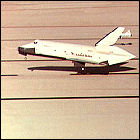 For the third time, Space Shuttle Enterprise separates from the back of a Boeing 747 flying at nearly 25,000 feet above the dry lake bed landing strips at Edwards Air Force Base in California. With astronauts Fred Haise and Gordon Fullerton aboard, Enterprise safely glides to her third safe landing at Edwards. This is the last of the test landings to leave the aerodynamic tail cone over Enterprise’s “anatomically correct” (but nonfunctional) main engines; the remaining Approach & Landing test flights will test the aerodynamics of an orbiter as it would return from space with those engines exposed.
For the third time, Space Shuttle Enterprise separates from the back of a Boeing 747 flying at nearly 25,000 feet above the dry lake bed landing strips at Edwards Air Force Base in California. With astronauts Fred Haise and Gordon Fullerton aboard, Enterprise safely glides to her third safe landing at Edwards. This is the last of the test landings to leave the aerodynamic tail cone over Enterprise’s “anatomically correct” (but nonfunctional) main engines; the remaining Approach & Landing test flights will test the aerodynamics of an orbiter as it would return from space with those engines exposed.
Enterprise Approach & Landing Test 2
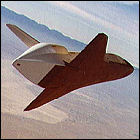 For the second time, the Space Shuttle Enterprise makes a safe landing at Edwards Air Force base after being released from the back of NASA’s 747 Shuttle Carrier Aircraft at the higher altitude of 26,000 feet over the Mojave Desert. Again testing the shuttle’s glide-only landing method, Enterprise has no engines to keep it aloft and glides to a successful landing.
For the second time, the Space Shuttle Enterprise makes a safe landing at Edwards Air Force base after being released from the back of NASA’s 747 Shuttle Carrier Aircraft at the higher altitude of 26,000 feet over the Mojave Desert. Again testing the shuttle’s glide-only landing method, Enterprise has no engines to keep it aloft and glides to a successful landing.
Space Shuttle external tank
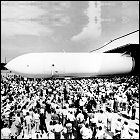 The first Space Shuttle external tank, given the designation MPTA-ET (main propulsion test article external tank), is completed at NASA’a Michoud assembly plant in New Orleans. Though constructed to flight specifications (as they stand in 1977), MPTA-ET is not intended for orbital flight, but is instead erected on a test firing stand at a NASA facility in Mississippi for tests of the three-engine shuttle propulsion system, tests which do not produce a satisfactory result until July 1980. Its job completed, MPTA-ET is later put on display at the U.S. Space & Rocket Center in Huntsville, Alabama.
The first Space Shuttle external tank, given the designation MPTA-ET (main propulsion test article external tank), is completed at NASA’a Michoud assembly plant in New Orleans. Though constructed to flight specifications (as they stand in 1977), MPTA-ET is not intended for orbital flight, but is instead erected on a test firing stand at a NASA facility in Mississippi for tests of the three-engine shuttle propulsion system, tests which do not produce a satisfactory result until July 1980. Its job completed, MPTA-ET is later put on display at the U.S. Space & Rocket Center in Huntsville, Alabama.
Enterprise Approach & Landing Test 1
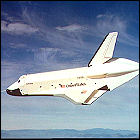 Released from its 747 Shuttle Carrier Aircraft in mid-air for the first time, and airborne on its own for the first time, the Space Shuttle Enterprise takes wing over the dry lake bed at Edwards Air Force Base for a test landing. With no engines on board (a test shuttle that will never go into orbit, Enterprise isn’t equipped with them) and only one shot at a safe landing, Enterprise successfully touches down on the runway after a flight lasting only a few minutes, validating the unpowered approach method of landing a shuttle just returned from space.
Released from its 747 Shuttle Carrier Aircraft in mid-air for the first time, and airborne on its own for the first time, the Space Shuttle Enterprise takes wing over the dry lake bed at Edwards Air Force Base for a test landing. With no engines on board (a test shuttle that will never go into orbit, Enterprise isn’t equipped with them) and only one shot at a safe landing, Enterprise successfully touches down on the runway after a flight lasting only a few minutes, validating the unpowered approach method of landing a shuttle just returned from space.
Enterprise goes around the block again
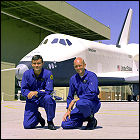 Space Shuttle Enterprise takes off – on the back of a Boeing 747 – for the last of its “active-captive” flights, with a crew aboard and all systems powered up. For this final test flight prior to the first free-flight landing test mere weeks away, Enterprise is again crewed by astronauts Fred Haise and Gordon Fullerton, and reaches an altitude of 30,000 feet.
Space Shuttle Enterprise takes off – on the back of a Boeing 747 – for the last of its “active-captive” flights, with a crew aboard and all systems powered up. For this final test flight prior to the first free-flight landing test mere weeks away, Enterprise is again crewed by astronauts Fred Haise and Gordon Fullerton, and reaches an altitude of 30,000 feet.
Enterprise takes to the sky again
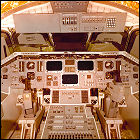 Riding the back of a modified Boeing 747, Space Shuttle Enterprise ascends to 22,000 feet for her second “active-captive” test flight, with all systems powered up and a crew aboard (astronauts Joe Engle and Richard Truly). The combined vehicle reaches speeds of over 300 miles per hour, and angles for “dropoff” – for upcoming test flights in which the Enterprise will actually separate from the 747 and glide to its landing strip – are studied for future reference.
Riding the back of a modified Boeing 747, Space Shuttle Enterprise ascends to 22,000 feet for her second “active-captive” test flight, with all systems powered up and a crew aboard (astronauts Joe Engle and Richard Truly). The combined vehicle reaches speeds of over 300 miles per hour, and angles for “dropoff” – for upcoming test flights in which the Enterprise will actually separate from the 747 and glide to its landing strip – are studied for future reference.
Enterprise takes another test drive
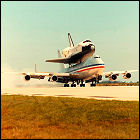 Mounted on the back of Boeing 747, the Space Shuttle Enterprise takes off on its first crewed flight, the first of three “captive-active” flights which see Enterprise remain in place on its carrier aircraft. For the first time, Enterprise’s computers, avionics and other flight systems are powered up in a full-up, hour-long dress rehearsal of an eventual free-flight landing test at 15,000 feet. The first crew of the Space Shuttle Enterprise consists of astronauts Fred Haise and Gordon Fullerton.
Mounted on the back of Boeing 747, the Space Shuttle Enterprise takes off on its first crewed flight, the first of three “captive-active” flights which see Enterprise remain in place on its carrier aircraft. For the first time, Enterprise’s computers, avionics and other flight systems are powered up in a full-up, hour-long dress rehearsal of an eventual free-flight landing test at 15,000 feet. The first crew of the Space Shuttle Enterprise consists of astronauts Fred Haise and Gordon Fullerton.
Enterprise test drive
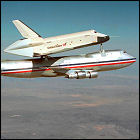 Mated to its Boeing 747 Shuttle Carrier Aircraft, Space Shuttle Enterprise goes airborne for the first time in the first of a series of “captive-inert” test flights. During these flights, there is no crew aboard Enterprise, nor are any of the test shuttle’s systems powered up; the flights are intended to make sure that the combination of the 747 and the Enterprise is capable of being flown safely. Further “captive-inert” flights are carried out over a ten-day period.
Mated to its Boeing 747 Shuttle Carrier Aircraft, Space Shuttle Enterprise goes airborne for the first time in the first of a series of “captive-inert” test flights. During these flights, there is no crew aboard Enterprise, nor are any of the test shuttle’s systems powered up; the flights are intended to make sure that the combination of the 747 and the Enterprise is capable of being flown safely. Further “captive-inert” flights are carried out over a ten-day period.
Enterprise hails a taxi
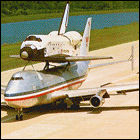 Space Shuttle Enterprise, mated to the heavily-modified Boeing 747 Shuttle Carrier Aircraft (SCA) for the first time, undergoes three “taxi tests” to enusre the structural stability of the two-vehicle combination on the runway before they ever take off. This is the first phase of a series of tests that will culminate, later in 1977, in a series of brief unpowered flights and landing tests using the Enterprise, verifying the shuttle’s gliding aerodynamics.
Space Shuttle Enterprise, mated to the heavily-modified Boeing 747 Shuttle Carrier Aircraft (SCA) for the first time, undergoes three “taxi tests” to enusre the structural stability of the two-vehicle combination on the runway before they ever take off. This is the first phase of a series of tests that will culminate, later in 1977, in a series of brief unpowered flights and landing tests using the Enterprise, verifying the shuttle’s gliding aerodynamics.
Enterprise leaves drydock
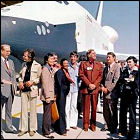 On schedule, the Space Shuttle Enterprise is rolled out of the Rockwell International plant in Palmdale, California to much public fanfare, a ceremony including Star Trek creator Gene Roddenberry and most of the cast who played the crew of the Enterprise’s fictional namesake (William Shatner was conspicuously absent). The timing of the rollout, ironically, was intended to roll the test shuttle – originally named Constitution – out of the hangar on Constitution Day during the bicentennial year.
On schedule, the Space Shuttle Enterprise is rolled out of the Rockwell International plant in Palmdale, California to much public fanfare, a ceremony including Star Trek creator Gene Roddenberry and most of the cast who played the crew of the Enterprise’s fictional namesake (William Shatner was conspicuously absent). The timing of the rollout, ironically, was intended to roll the test shuttle – originally named Constitution – out of the hangar on Constitution Day during the bicentennial year.
Enterprise in drydock
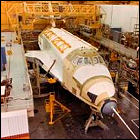 Construction begins on OV-101, a Space Shuttle intended for extensive atmospheric test flight and landings without ever going into space. Originally intended to bear the name Constitution, a letter-writing campaign by Star Trek fans convinces President Gerald Ford to request that NASA rename the first shuttle Enterprise. Much of the first shuttle’s structural details are simply dummy models of the correct shape and weight; her engines are never intended to fire. Though plans are drawn up to convert Enterprise into a space-worthy vehicle, they are never carried out: it’s deemed cheaper and faster to upgrade a structural test model of the shuttle instead.
Construction begins on OV-101, a Space Shuttle intended for extensive atmospheric test flight and landings without ever going into space. Originally intended to bear the name Constitution, a letter-writing campaign by Star Trek fans convinces President Gerald Ford to request that NASA rename the first shuttle Enterprise. Much of the first shuttle’s structural details are simply dummy models of the correct shape and weight; her engines are never intended to fire. Though plans are drawn up to convert Enterprise into a space-worthy vehicle, they are never carried out: it’s deemed cheaper and faster to upgrade a structural test model of the shuttle instead.